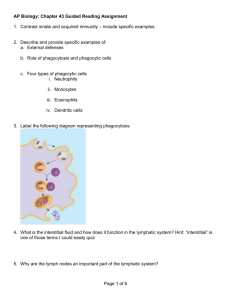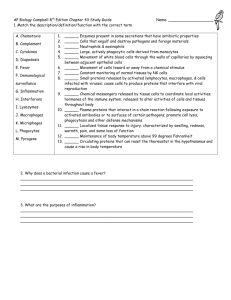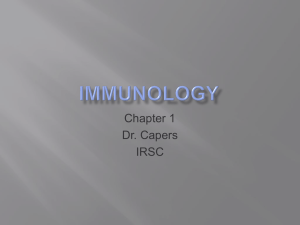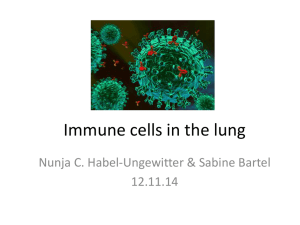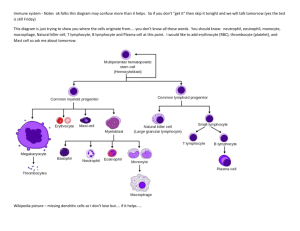Document
advertisement
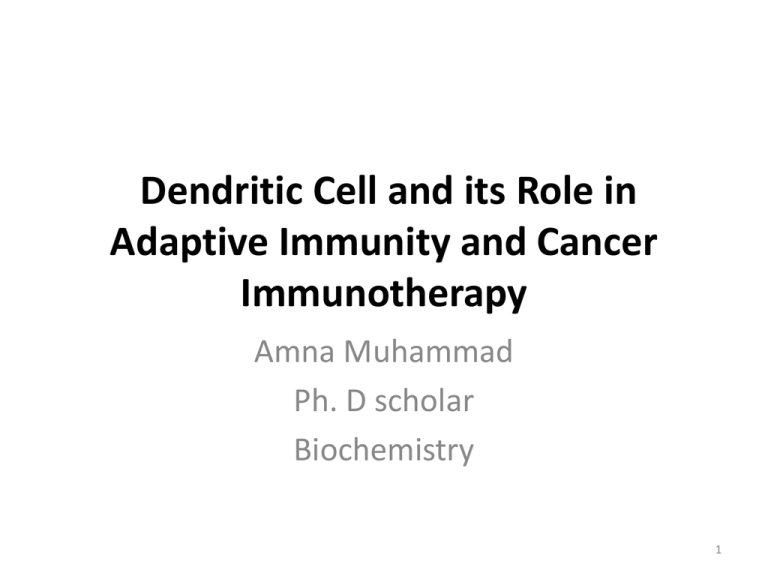
Dendritic Cell and its Role in Adaptive Immunity and Cancer Immunotherapy Amna Muhammad Ph. D scholar Biochemistry 1 Contents • Introduction • Dentritic cell and control of immunity • Immunity • Antigen Presentation to T cells • Dendritic Cell and Immune Tolerance • Dendritic cells and cancer • Summary • References 2 Introduction • Immunology has long been focused: • Antigen is any substance that causes your immune system to produce antibodies against it • Lymphocytes are responsible for immune responses. There are two main types of B cells and T cells 3 • But the mere presence of these two parties does not always lead to immunity. • A third party is required • Dendritic cell (DC) system - Initiator and modulator of the immune response 4 • How does the immune system respond to different infections? 5 6 Types of immunity • Adaptive immunity • Innate immunity 7 8 Adaptive Immunity • The adaptive immune or specific immune response consists of antibody responses and cell-mediated responses. • Both responses are carried out by – B cells – T cells 9 T cells • Two main types: 1. CD4+: Stimulate other immune cells. 2. CD8+ Cytotoxic T cells: Kill intracellularly-infected cells. • Two major types of CD4+ T cells: 1. TH1: Inflammatory T cells -- Stimulate macrophages and promote inflammatory responses. 2. TH2: Helper T cells -- Stimulate B-cells to produce antibodies. 10 Antigen Presentation to T cells • Antigens are presented to T cells as short peptide fragments bound to (MHC) molecules. • Two types of MHC in humans and mice: – MHC I: presents an 8-10 amino acid peptide to CD8+ T cells. – MHC II: presents a longer peptide (13 aa or more) to CD4+ T cells. 11 MHC / T cell Interactions target cell Class I MHC CD8 CD8+ T cell Class II MHC Antigen presenting cell CD4 TCR complex TCR complex CD4+ T cell 12 CD4+ T cell Activation • Three signals are required for T cell activation 1. Activation by antigen specific signal – ( peptide/MHC-TCR binding) 2. Co-stimulatory signal – CD28/CD80 3. Polarization signal 13 14 CD8+ T cell Activation • Activation by displaying MHC I/peptide • co-stimulation • Activation of the CD8+ cell causes up-regulation of the IL-2 receptor and production of IL-2, leading to growth and proliferation. 15 16 17 Introduction to Dendritic cell (DC) system • Professional antigen presenting cells • Regulation of adaptive immune response • Tolerize T cells to self-antigens 18 Dendritic Cells and Control of Immunity o Control B and T cell function Capturing antigen Antigen processing Expression of antigen co-stimulatory molecules Migration to lymphoid organ Secretion of cytokines Activation of lymphocytes 19 Capturing Antigen • Phagocytosis • Macropinocytosis • Receptor mediated adsorptive endocytosis 20 Antigen Processing • Antigen is fully digested into amino acids • Loaded onto MHC class II molecules • Antigen MHCII complexes are send to cell surface 21 Antigen Processing Display of MHC II + peptide on cell surface Ingestion of microbe Vesicle fusion, assembly of peptide/MHC II Vesicle carrying MHC II Degradtion in lysozome MHC II is assembled in ER Endoplasmic reticulum Nucleus 22 Maturation of DC Immature DC Mature DC High intracellular MHC II High surface MHC II Many antigen capturing receptors Very less antigen capturing receptors Weak T cell stimulator Powerful T cell stimulator 23 Migration of Dendritic Cells • Loss of adhesion • Travelling to lymphoid tissues • Induce T cell response 24 25 Dendritic Cell and Immune Tolerance 26 Immune Tolerence • Immune system important task is to - identify what is foreign and what is self • Failure results in an autoimmune disease • Diabetes mellitus type 1 or multiple sclerosis etc 27 Thymic Selection 28 29 DC and Cancer • Constitutive activation of STAT 3 pathway leads to tumor expression and suppression of dentritic cells • Commensurate with their roles in regulating cytokine-dependent inflammation and immunity, signal transducer and activator of transcription (STAT) proteins are central in determining whether immune responses in the tumour microenvironment promote or inhibit cancer. 30 31 Dentritic Cells and Vaccine 32 Cont… • Until recently, most DC vaccines comprised DC or monocyte precursors of DC, isolated from the patient, loaded ex vivo with tumour antigen (Ag), and readministered to the patient. DC that migrated from the injection site to the draining lymph nodes were expected to prime or boost memory, tumour-specific T cells capable of eradicating the tumour. • To date, the majority of trials have been Phase I studies on small cohorts of advanced cancer patients who had failed to respond to conventional therapies 33 Cont… • These trials revealed that this approach: (1) is feasible in many malignancies; (2) is well tolerated with minimal toxicity; and (3) can induce tumour-specific immune responses in many patients. • Whilst early DC therapies resulted in limited clinical benefits, recent advances in our understanding of DC biology and new knowledge obtained from clinical trials have identified new strategies that are expected to improve clinical outcomes. Harnessing the unique capacity of different DC subtypes to drive specific immune responses in combinations with approaches designed to overcome tumour-mediated immune suppression and immune regulation, are emerging as key strategies for the 34 development of new generation DC vaccines. DC pattern recognition receptors for cancer immunotherapy • DC subsets express a range of unique and shared pattern recognition receptors (PRR), including CLRs and TLRs that can be harnessed to enhance the efficacy of cancer immunotherapy. • Monoclonal antibodies (mAbs) specific for CLRs can be used to target Ag directly to particular DC subset(s) in vivo. This attractive approach circumvents the issues of poor DC migration. 35 Summary 36 Key Notes • NF-κB (nuclear factor kappa-light-chainenhancer of activated B cells) • MHC (major histocompatibilty complex) • INF (interferon) • IL (interleukin) • CD4 ( cluster of differentiation 4) 37 References • Steinman, R. M. and J. Banchereau. 2007. Taking dentritic cells into medicine. Nature. 449: 419-425 • Banchereau, J. and R. M. Steinman (1998). Dentritic cells and the control of immunity. Nature. 392: 245-252 • Yu, H., D. Pardoll and R. Jove .2009. STATs in cancer inflammation and immunity: a leading role for STAT3. Nature Reviews Cancer. 9: 798-809 • Oriss, B. Timothy , Krishnamoorthy, N. Ray, P. Ray, Anuradha. 2014. Dendritic cell c-kit signaling and adaptive immunity: implications for the upper airways. Current Opinion in Allergy & Clinical Immunology. 14:7-5 38
